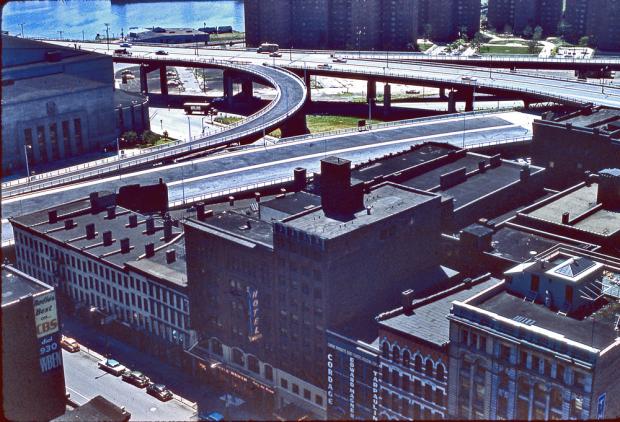Looking Backward: Lower Main Street, 1958
Lower Main Street—a place heavy with history and memory—was the center of Buffalo’s waterfront economy for more than a century. Here, in a photograph taken by City Hall staffers in 1958, is the west side of Main Street between Upper Terrace and Seneca Street, slated for urban renewal. This is one of the blocks that County Executive John Tutuska called, in the 1969 groundbreaking ceremony for Marine Midland Center, a “rundown, disheveled, unkempt, and neglected area.” To the upper left, the I-190 is under construction. Along Main Street, from left to right, are the Root, Neal & Co. industrial supplies, International Union of North American Seafarers, Lighting Fixture Co., Louis Karnofsky’s tailor shop, Sidway Block, Ye Olde Knight Tavern, Hotel Worth, Edward Magner & Sons marine supplies, Buffalo Mill Supply Co., and Buffalo Evening News.
The Lower Main Street makeover was not intended to eliminate blight, but to transfer land to the Marine Midland Trust Co., which could assemble the parcels only through the Buffalo Urban Renewal Agency’s condemnation and eminent domain powers. The Buffalo Evening News, whose office building is pictured on the lower right, was a cheerleader for the renewal project—no surprise, since the proceeds from the sale of its facility would bankroll a new headquarters at Washington and Scott streets. (Whether other property owners were enthusiastic sellers, the Buffalo Evening News leaves no record.) By 1972, the two blocks of 44 buildings between Pearl Street, Washington Street, Exchange Street, Upper Terrace, and Seneca Street would be replaced with one building—Marine Midland Center. At the groundbreaking, Robert Scheu, CEO of Marine Midland Trust, called the destruction of this historic waterfront area “the rebirth of this historic waterfront area.” Today, the tower—a modernist landmark designed by Skidmore, Owings & Merrill that has become historic in its own right—is virtually empty.

